Analysis: House Prices, Immigration Rates, and Economic Factors
VerifiedAdded on 2020/03/28
|15
|3831
|193
Report
AI Summary
This report investigates the complex relationship between house prices and immigration rates, exploring the economic factors at play. The study begins with an introduction highlighting the significance of international migration as a social and economic factor influencing housing prices. The project objectives include examining the correlation between house prices and immigration rates, assessing influencing factors, and analyzing supply and demand changes between 2000-2010 and 2011-2017. The literature review delves into the positive correlation between house prices and immigration, examining how immigration affects housing prices across different countries, and the impact of immigration rates on housing costs. The research methodology involves secondary data analysis and qualitative research to assess the impact of immigration on housing markets, including a review of the prices of houses and the rate of immigration from 2000-2017. The report also discusses research limitations and concludes with a summary of the findings.
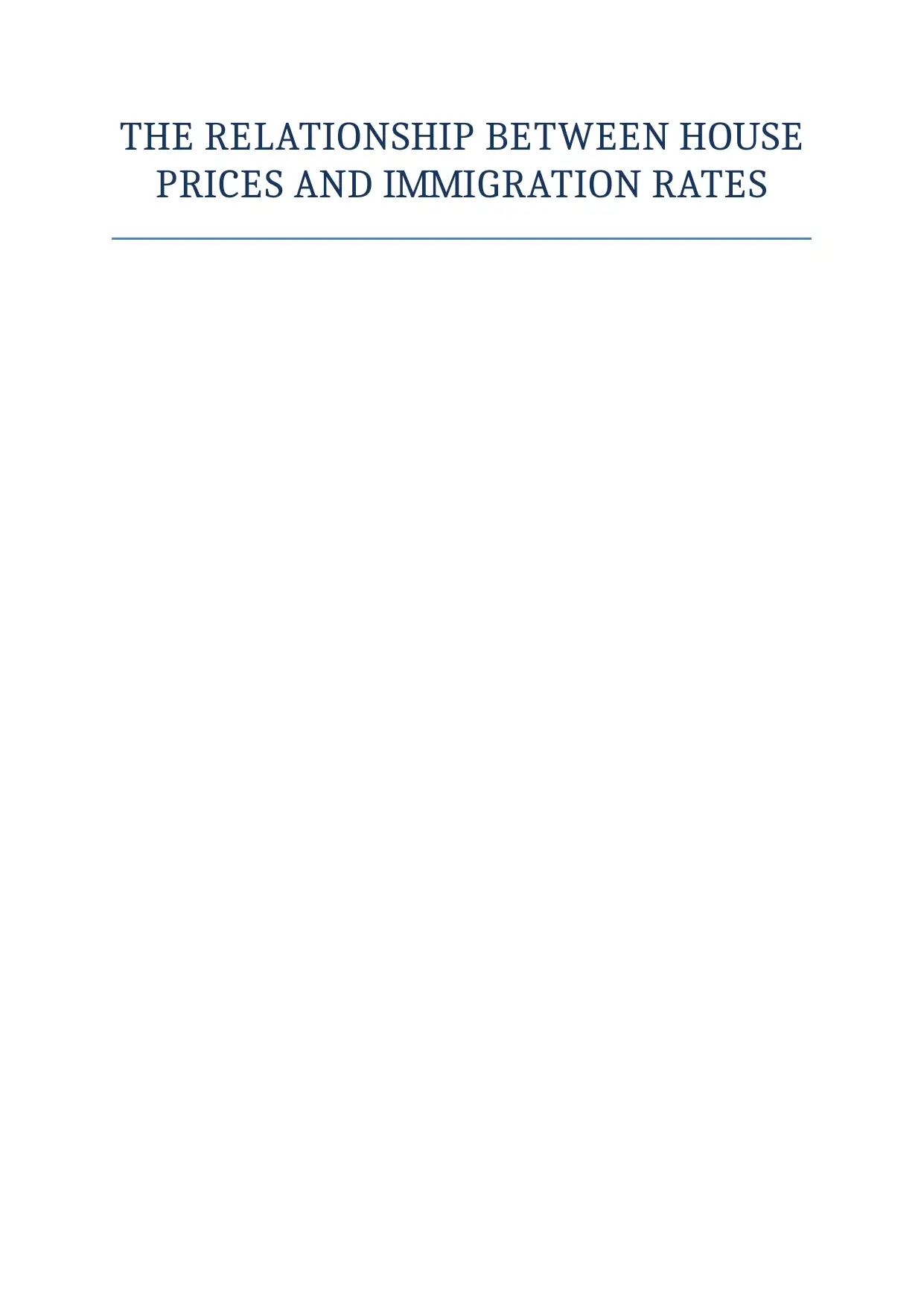
THE RELATIONSHIP BETWEEN HOUSE
PRICES AND IMMIGRATION RATES
PRICES AND IMMIGRATION RATES
Paraphrase This Document
Need a fresh take? Get an instant paraphrase of this document with our AI Paraphraser
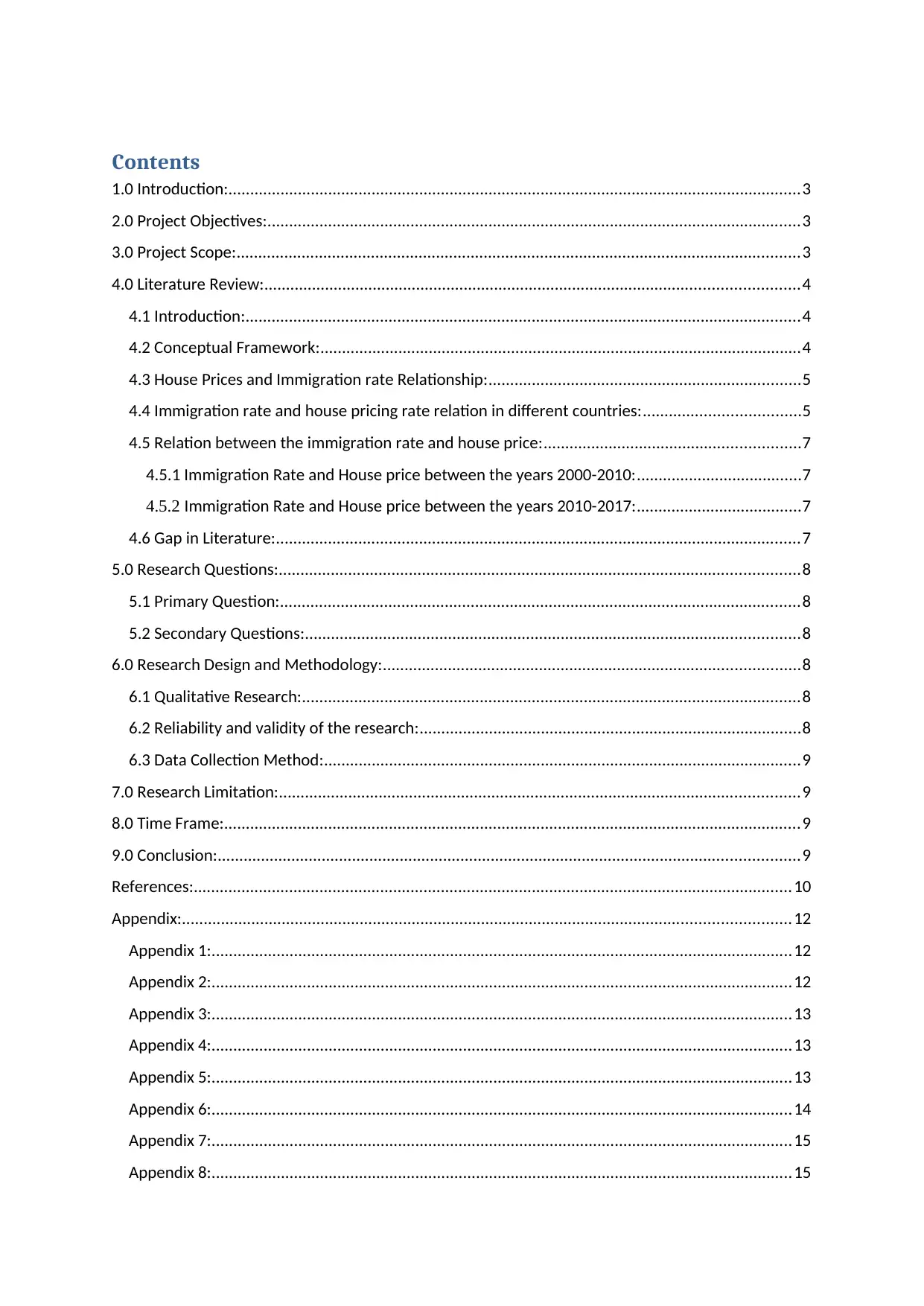
Contents
1.0 Introduction:....................................................................................................................................3
2.0 Project Objectives:...........................................................................................................................3
3.0 Project Scope:..................................................................................................................................3
4.0 Literature Review:...........................................................................................................................4
4.1 Introduction:................................................................................................................................4
4.2 Conceptual Framework:...............................................................................................................4
4.3 House Prices and Immigration rate Relationship:........................................................................5
4.4 Immigration rate and house pricing rate relation in different countries:....................................5
4.5 Relation between the immigration rate and house price:...........................................................7
4.5.1 Immigration Rate and House price between the years 2000-2010:......................................7
4.5.2 Immigration Rate and House price between the years 2010-2017:......................................7
4.6 Gap in Literature:.........................................................................................................................7
5.0 Research Questions:........................................................................................................................8
5.1 Primary Question:........................................................................................................................8
5.2 Secondary Questions:..................................................................................................................8
6.0 Research Design and Methodology:................................................................................................8
6.1 Qualitative Research:...................................................................................................................8
6.2 Reliability and validity of the research:........................................................................................8
6.3 Data Collection Method:..............................................................................................................9
7.0 Research Limitation:........................................................................................................................9
8.0 Time Frame:.....................................................................................................................................9
9.0 Conclusion:......................................................................................................................................9
References:..........................................................................................................................................10
Appendix:............................................................................................................................................12
Appendix 1:......................................................................................................................................12
Appendix 2:......................................................................................................................................12
Appendix 3:......................................................................................................................................13
Appendix 4:......................................................................................................................................13
Appendix 5:......................................................................................................................................13
Appendix 6:......................................................................................................................................14
Appendix 7:......................................................................................................................................15
Appendix 8:......................................................................................................................................15
1.0 Introduction:....................................................................................................................................3
2.0 Project Objectives:...........................................................................................................................3
3.0 Project Scope:..................................................................................................................................3
4.0 Literature Review:...........................................................................................................................4
4.1 Introduction:................................................................................................................................4
4.2 Conceptual Framework:...............................................................................................................4
4.3 House Prices and Immigration rate Relationship:........................................................................5
4.4 Immigration rate and house pricing rate relation in different countries:....................................5
4.5 Relation between the immigration rate and house price:...........................................................7
4.5.1 Immigration Rate and House price between the years 2000-2010:......................................7
4.5.2 Immigration Rate and House price between the years 2010-2017:......................................7
4.6 Gap in Literature:.........................................................................................................................7
5.0 Research Questions:........................................................................................................................8
5.1 Primary Question:........................................................................................................................8
5.2 Secondary Questions:..................................................................................................................8
6.0 Research Design and Methodology:................................................................................................8
6.1 Qualitative Research:...................................................................................................................8
6.2 Reliability and validity of the research:........................................................................................8
6.3 Data Collection Method:..............................................................................................................9
7.0 Research Limitation:........................................................................................................................9
8.0 Time Frame:.....................................................................................................................................9
9.0 Conclusion:......................................................................................................................................9
References:..........................................................................................................................................10
Appendix:............................................................................................................................................12
Appendix 1:......................................................................................................................................12
Appendix 2:......................................................................................................................................12
Appendix 3:......................................................................................................................................13
Appendix 4:......................................................................................................................................13
Appendix 5:......................................................................................................................................13
Appendix 6:......................................................................................................................................14
Appendix 7:......................................................................................................................................15
Appendix 8:......................................................................................................................................15
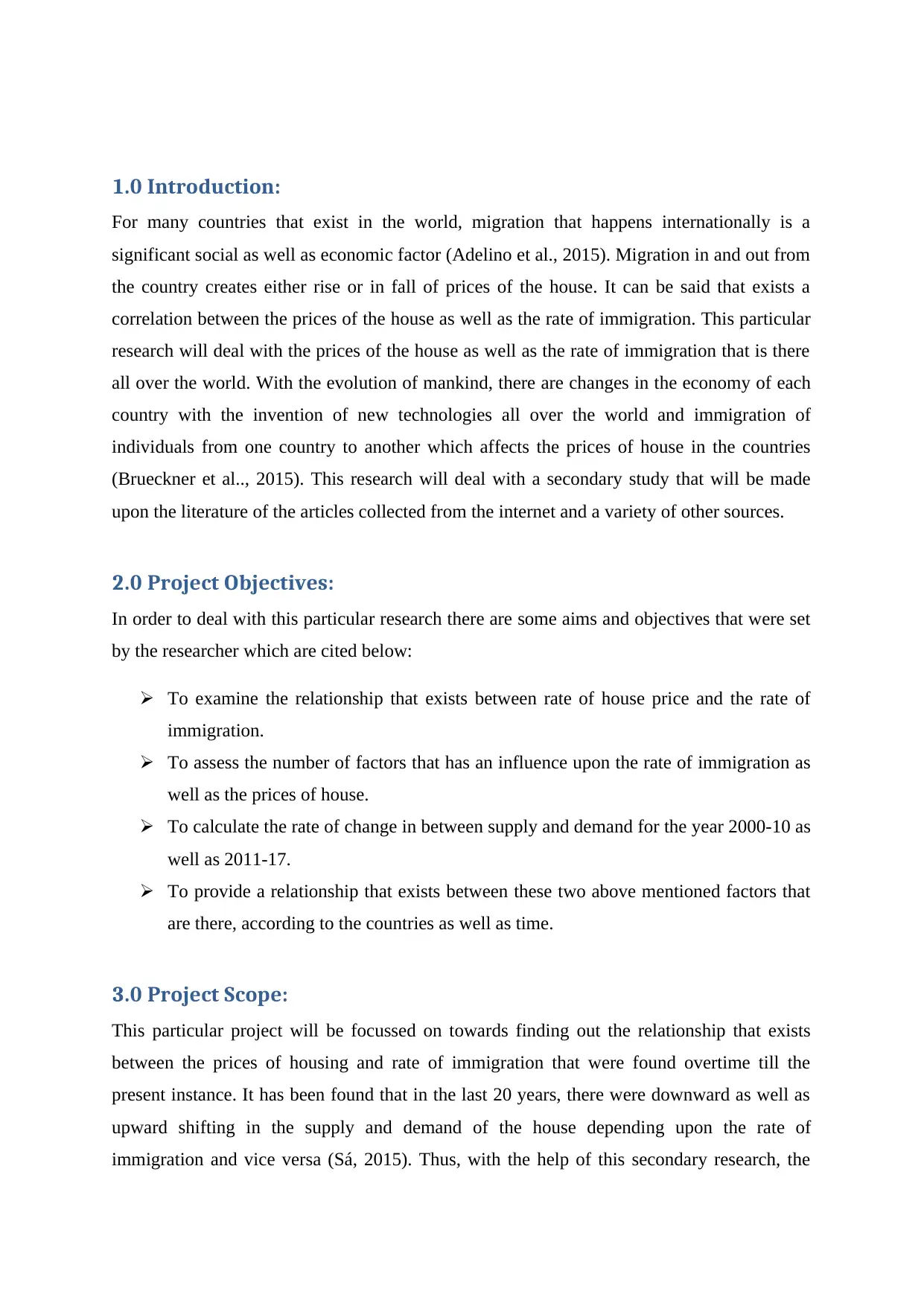
1.0 Introduction:
For many countries that exist in the world, migration that happens internationally is a
significant social as well as economic factor (Adelino et al., 2015). Migration in and out from
the country creates either rise or in fall of prices of the house. It can be said that exists a
correlation between the prices of the house as well as the rate of immigration. This particular
research will deal with the prices of the house as well as the rate of immigration that is there
all over the world. With the evolution of mankind, there are changes in the economy of each
country with the invention of new technologies all over the world and immigration of
individuals from one country to another which affects the prices of house in the countries
(Brueckner et al.., 2015). This research will deal with a secondary study that will be made
upon the literature of the articles collected from the internet and a variety of other sources.
2.0 Project Objectives:
In order to deal with this particular research there are some aims and objectives that were set
by the researcher which are cited below:
To examine the relationship that exists between rate of house price and the rate of
immigration.
To assess the number of factors that has an influence upon the rate of immigration as
well as the prices of house.
To calculate the rate of change in between supply and demand for the year 2000-10 as
well as 2011-17.
To provide a relationship that exists between these two above mentioned factors that
are there, according to the countries as well as time.
3.0 Project Scope:
This particular project will be focussed on towards finding out the relationship that exists
between the prices of housing and rate of immigration that were found overtime till the
present instance. It has been found that in the last 20 years, there were downward as well as
upward shifting in the supply and demand of the house depending upon the rate of
immigration and vice versa (Sá, 2015). Thus, with the help of this secondary research, the
For many countries that exist in the world, migration that happens internationally is a
significant social as well as economic factor (Adelino et al., 2015). Migration in and out from
the country creates either rise or in fall of prices of the house. It can be said that exists a
correlation between the prices of the house as well as the rate of immigration. This particular
research will deal with the prices of the house as well as the rate of immigration that is there
all over the world. With the evolution of mankind, there are changes in the economy of each
country with the invention of new technologies all over the world and immigration of
individuals from one country to another which affects the prices of house in the countries
(Brueckner et al.., 2015). This research will deal with a secondary study that will be made
upon the literature of the articles collected from the internet and a variety of other sources.
2.0 Project Objectives:
In order to deal with this particular research there are some aims and objectives that were set
by the researcher which are cited below:
To examine the relationship that exists between rate of house price and the rate of
immigration.
To assess the number of factors that has an influence upon the rate of immigration as
well as the prices of house.
To calculate the rate of change in between supply and demand for the year 2000-10 as
well as 2011-17.
To provide a relationship that exists between these two above mentioned factors that
are there, according to the countries as well as time.
3.0 Project Scope:
This particular project will be focussed on towards finding out the relationship that exists
between the prices of housing and rate of immigration that were found overtime till the
present instance. It has been found that in the last 20 years, there were downward as well as
upward shifting in the supply and demand of the house depending upon the rate of
immigration and vice versa (Sá, 2015). Thus, with the help of this secondary research, the
⊘ This is a preview!⊘
Do you want full access?
Subscribe today to unlock all pages.

Trusted by 1+ million students worldwide
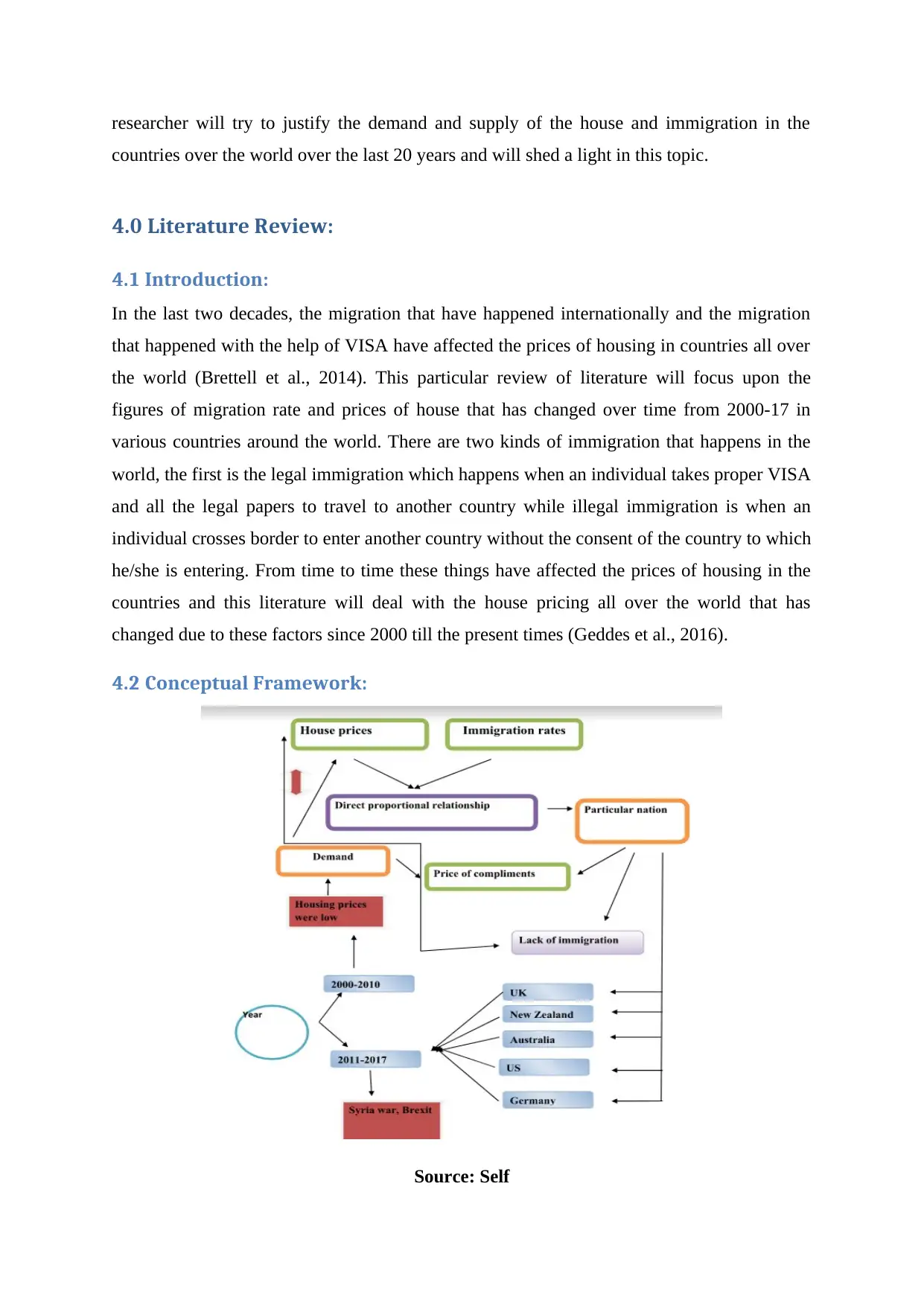
researcher will try to justify the demand and supply of the house and immigration in the
countries over the world over the last 20 years and will shed a light in this topic.
4.0 Literature Review:
4.1 Introduction:
In the last two decades, the migration that have happened internationally and the migration
that happened with the help of VISA have affected the prices of housing in countries all over
the world (Brettell et al., 2014). This particular review of literature will focus upon the
figures of migration rate and prices of house that has changed over time from 2000-17 in
various countries around the world. There are two kinds of immigration that happens in the
world, the first is the legal immigration which happens when an individual takes proper VISA
and all the legal papers to travel to another country while illegal immigration is when an
individual crosses border to enter another country without the consent of the country to which
he/she is entering. From time to time these things have affected the prices of housing in the
countries and this literature will deal with the house pricing all over the world that has
changed due to these factors since 2000 till the present times (Geddes et al., 2016).
4.2 Conceptual Framework:
Source: Self
countries over the world over the last 20 years and will shed a light in this topic.
4.0 Literature Review:
4.1 Introduction:
In the last two decades, the migration that have happened internationally and the migration
that happened with the help of VISA have affected the prices of housing in countries all over
the world (Brettell et al., 2014). This particular review of literature will focus upon the
figures of migration rate and prices of house that has changed over time from 2000-17 in
various countries around the world. There are two kinds of immigration that happens in the
world, the first is the legal immigration which happens when an individual takes proper VISA
and all the legal papers to travel to another country while illegal immigration is when an
individual crosses border to enter another country without the consent of the country to which
he/she is entering. From time to time these things have affected the prices of housing in the
countries and this literature will deal with the house pricing all over the world that has
changed due to these factors since 2000 till the present times (Geddes et al., 2016).
4.2 Conceptual Framework:
Source: Self
Paraphrase This Document
Need a fresh take? Get an instant paraphrase of this document with our AI Paraphraser

4.3 House Prices and Immigration rate Relationship:
While it is compared to the context of the nation, it can be found that there exists a positive
correlation between the prices of the house and migration rate. As stated by Sa (2015), when
the price of house increases with immigration, it is expected that the price of the rate of
immigration will rise more during the future period of time (Sá, 2015). He further extended
that it can be stated that there is an affirmative co-relationship that exists between the rising
of house prices in a country and the rate of immigration to that of country. When the
immigration of a country rises at national level, then automatically the prices of the house
also increase. As it has been stated by Wadsworth et al. (2016), with the help of First
Economy Theory application, the rise of household income can give a rise in the price of
house and along with that there are certain other factors that can contribute to that rise and
they are pricing of compliment products and also the pricing of substitute goods, which in
this case are the flats and mortgages (Wadsworth et al., 2016).
As stated by Saiz (2008), even if there is high demand for house inside the country, when the
rate of immigration is low, it can cause downfall to the housing prices. For instance,
according to Shi et al., (2015), the citizens of the country and the long term immigrants while
contribute 0.1% of the income to the country while the natural population boost contributes
0.8% to the country’s economy (Riley et al., 2015). But other studies states that if there is 1%
increase in the population of the immigrants the rate of house increases by 12.6% in the
country. The relation that exists between the immigration and the rise in house pricing can be
seen from the table in Appendix 1.
The inflation in the prices of house is mainly due to the migrants and they contribute towards
a nation’s economy with the help of creation of inflationary pressure (Ferrero, 2015). Also
rise in the house prices in a country contributes towards domestic spending and also drives up
the prices of domestic goods. Shi et al., (2015) stated that how the mortgage raised the price
of houses during the 2008 financial crisis and during this time, there were many immigrants
that have entered NZ for the demand of houses in fewer prices. (Appendix 2)
4.4 Immigration rate and house pricing rate relation in different countries:
When there is a national debate in the topic of affordability, demand and supply, the
reduction rate in the supply and demand of houses is bound to arise (Gonzalez et al., 2013).
According to Accetturo et al., (2015), he stated that the prices of house vary from country to
country and the rate of immigration in those countries determines the prices of house. He
While it is compared to the context of the nation, it can be found that there exists a positive
correlation between the prices of the house and migration rate. As stated by Sa (2015), when
the price of house increases with immigration, it is expected that the price of the rate of
immigration will rise more during the future period of time (Sá, 2015). He further extended
that it can be stated that there is an affirmative co-relationship that exists between the rising
of house prices in a country and the rate of immigration to that of country. When the
immigration of a country rises at national level, then automatically the prices of the house
also increase. As it has been stated by Wadsworth et al. (2016), with the help of First
Economy Theory application, the rise of household income can give a rise in the price of
house and along with that there are certain other factors that can contribute to that rise and
they are pricing of compliment products and also the pricing of substitute goods, which in
this case are the flats and mortgages (Wadsworth et al., 2016).
As stated by Saiz (2008), even if there is high demand for house inside the country, when the
rate of immigration is low, it can cause downfall to the housing prices. For instance,
according to Shi et al., (2015), the citizens of the country and the long term immigrants while
contribute 0.1% of the income to the country while the natural population boost contributes
0.8% to the country’s economy (Riley et al., 2015). But other studies states that if there is 1%
increase in the population of the immigrants the rate of house increases by 12.6% in the
country. The relation that exists between the immigration and the rise in house pricing can be
seen from the table in Appendix 1.
The inflation in the prices of house is mainly due to the migrants and they contribute towards
a nation’s economy with the help of creation of inflationary pressure (Ferrero, 2015). Also
rise in the house prices in a country contributes towards domestic spending and also drives up
the prices of domestic goods. Shi et al., (2015) stated that how the mortgage raised the price
of houses during the 2008 financial crisis and during this time, there were many immigrants
that have entered NZ for the demand of houses in fewer prices. (Appendix 2)
4.4 Immigration rate and house pricing rate relation in different countries:
When there is a national debate in the topic of affordability, demand and supply, the
reduction rate in the supply and demand of houses is bound to arise (Gonzalez et al., 2013).
According to Accetturo et al., (2015), he stated that the prices of house vary from country to
country and the rate of immigration in those countries determines the prices of house. He
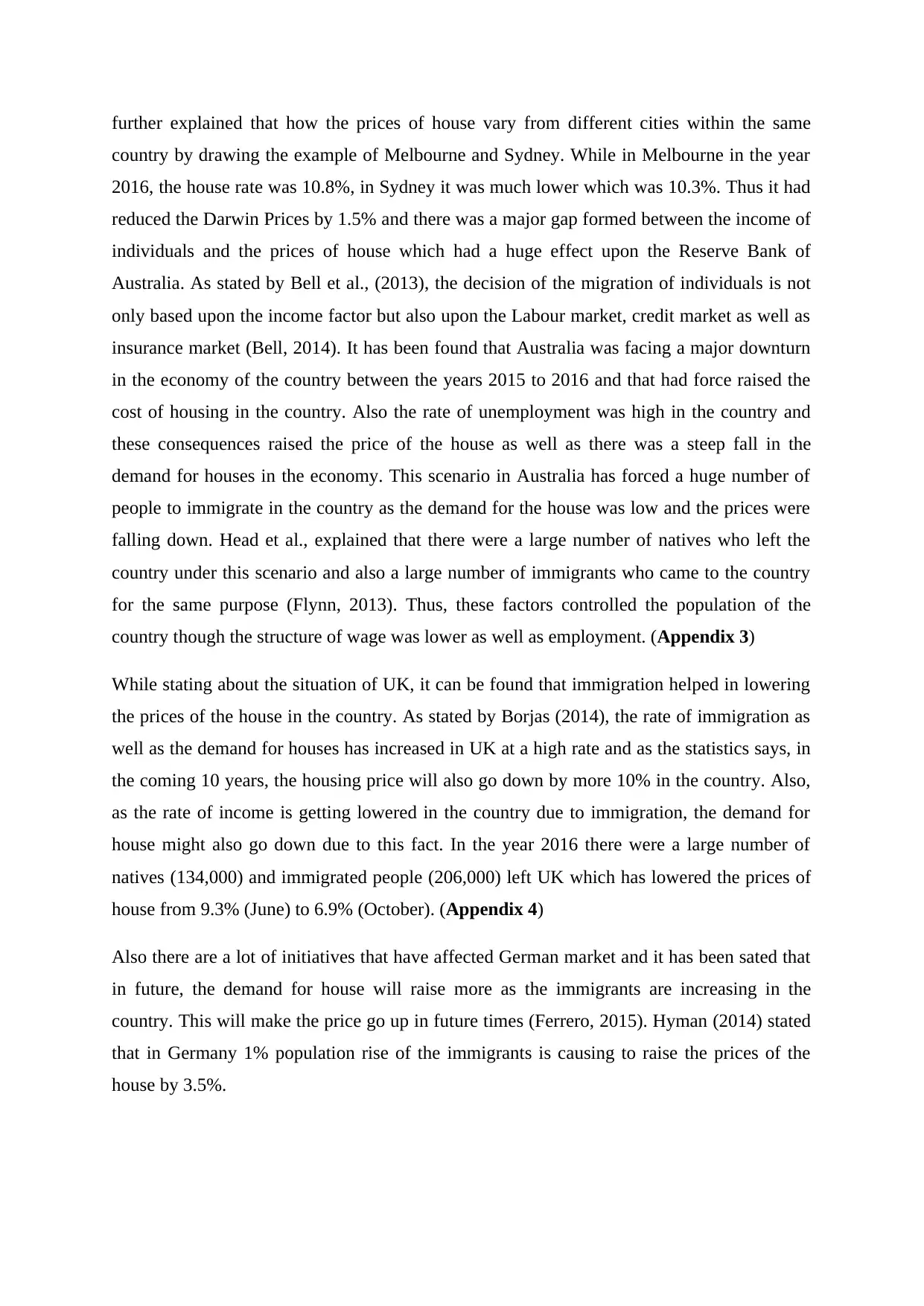
further explained that how the prices of house vary from different cities within the same
country by drawing the example of Melbourne and Sydney. While in Melbourne in the year
2016, the house rate was 10.8%, in Sydney it was much lower which was 10.3%. Thus it had
reduced the Darwin Prices by 1.5% and there was a major gap formed between the income of
individuals and the prices of house which had a huge effect upon the Reserve Bank of
Australia. As stated by Bell et al., (2013), the decision of the migration of individuals is not
only based upon the income factor but also upon the Labour market, credit market as well as
insurance market (Bell, 2014). It has been found that Australia was facing a major downturn
in the economy of the country between the years 2015 to 2016 and that had force raised the
cost of housing in the country. Also the rate of unemployment was high in the country and
these consequences raised the price of the house as well as there was a steep fall in the
demand for houses in the economy. This scenario in Australia has forced a huge number of
people to immigrate in the country as the demand for the house was low and the prices were
falling down. Head et al., explained that there were a large number of natives who left the
country under this scenario and also a large number of immigrants who came to the country
for the same purpose (Flynn, 2013). Thus, these factors controlled the population of the
country though the structure of wage was lower as well as employment. (Appendix 3)
While stating about the situation of UK, it can be found that immigration helped in lowering
the prices of the house in the country. As stated by Borjas (2014), the rate of immigration as
well as the demand for houses has increased in UK at a high rate and as the statistics says, in
the coming 10 years, the housing price will also go down by more 10% in the country. Also,
as the rate of income is getting lowered in the country due to immigration, the demand for
house might also go down due to this fact. In the year 2016 there were a large number of
natives (134,000) and immigrated people (206,000) left UK which has lowered the prices of
house from 9.3% (June) to 6.9% (October). (Appendix 4)
Also there are a lot of initiatives that have affected German market and it has been sated that
in future, the demand for house will raise more as the immigrants are increasing in the
country. This will make the price go up in future times (Ferrero, 2015). Hyman (2014) stated
that in Germany 1% population rise of the immigrants is causing to raise the prices of the
house by 3.5%.
country by drawing the example of Melbourne and Sydney. While in Melbourne in the year
2016, the house rate was 10.8%, in Sydney it was much lower which was 10.3%. Thus it had
reduced the Darwin Prices by 1.5% and there was a major gap formed between the income of
individuals and the prices of house which had a huge effect upon the Reserve Bank of
Australia. As stated by Bell et al., (2013), the decision of the migration of individuals is not
only based upon the income factor but also upon the Labour market, credit market as well as
insurance market (Bell, 2014). It has been found that Australia was facing a major downturn
in the economy of the country between the years 2015 to 2016 and that had force raised the
cost of housing in the country. Also the rate of unemployment was high in the country and
these consequences raised the price of the house as well as there was a steep fall in the
demand for houses in the economy. This scenario in Australia has forced a huge number of
people to immigrate in the country as the demand for the house was low and the prices were
falling down. Head et al., explained that there were a large number of natives who left the
country under this scenario and also a large number of immigrants who came to the country
for the same purpose (Flynn, 2013). Thus, these factors controlled the population of the
country though the structure of wage was lower as well as employment. (Appendix 3)
While stating about the situation of UK, it can be found that immigration helped in lowering
the prices of the house in the country. As stated by Borjas (2014), the rate of immigration as
well as the demand for houses has increased in UK at a high rate and as the statistics says, in
the coming 10 years, the housing price will also go down by more 10% in the country. Also,
as the rate of income is getting lowered in the country due to immigration, the demand for
house might also go down due to this fact. In the year 2016 there were a large number of
natives (134,000) and immigrated people (206,000) left UK which has lowered the prices of
house from 9.3% (June) to 6.9% (October). (Appendix 4)
Also there are a lot of initiatives that have affected German market and it has been sated that
in future, the demand for house will raise more as the immigrants are increasing in the
country. This will make the price go up in future times (Ferrero, 2015). Hyman (2014) stated
that in Germany 1% population rise of the immigrants is causing to raise the prices of the
house by 3.5%.
⊘ This is a preview!⊘
Do you want full access?
Subscribe today to unlock all pages.

Trusted by 1+ million students worldwide
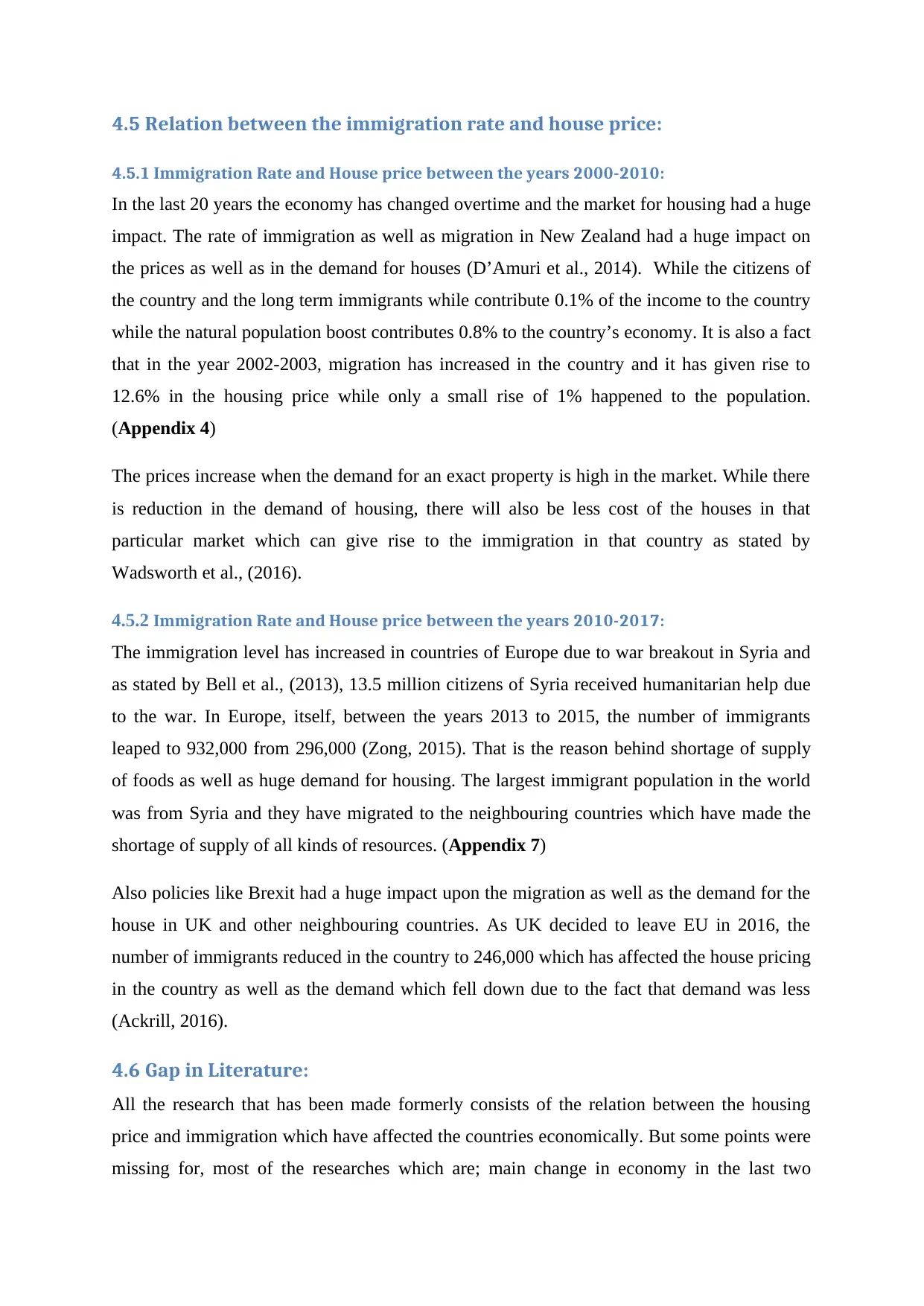
4.5 Relation between the immigration rate and house price:
4.5.1 Immigration Rate and House price between the years 2000-2010:
In the last 20 years the economy has changed overtime and the market for housing had a huge
impact. The rate of immigration as well as migration in New Zealand had a huge impact on
the prices as well as in the demand for houses (D’Amuri et al., 2014). While the citizens of
the country and the long term immigrants while contribute 0.1% of the income to the country
while the natural population boost contributes 0.8% to the country’s economy. It is also a fact
that in the year 2002-2003, migration has increased in the country and it has given rise to
12.6% in the housing price while only a small rise of 1% happened to the population.
(Appendix 4)
The prices increase when the demand for an exact property is high in the market. While there
is reduction in the demand of housing, there will also be less cost of the houses in that
particular market which can give rise to the immigration in that country as stated by
Wadsworth et al., (2016).
4.5.2 Immigration Rate and House price between the years 2010-2017:
The immigration level has increased in countries of Europe due to war breakout in Syria and
as stated by Bell et al., (2013), 13.5 million citizens of Syria received humanitarian help due
to the war. In Europe, itself, between the years 2013 to 2015, the number of immigrants
leaped to 932,000 from 296,000 (Zong, 2015). That is the reason behind shortage of supply
of foods as well as huge demand for housing. The largest immigrant population in the world
was from Syria and they have migrated to the neighbouring countries which have made the
shortage of supply of all kinds of resources. (Appendix 7)
Also policies like Brexit had a huge impact upon the migration as well as the demand for the
house in UK and other neighbouring countries. As UK decided to leave EU in 2016, the
number of immigrants reduced in the country to 246,000 which has affected the house pricing
in the country as well as the demand which fell down due to the fact that demand was less
(Ackrill, 2016).
4.6 Gap in Literature:
All the research that has been made formerly consists of the relation between the housing
price and immigration which have affected the countries economically. But some points were
missing for, most of the researches which are; main change in economy in the last two
4.5.1 Immigration Rate and House price between the years 2000-2010:
In the last 20 years the economy has changed overtime and the market for housing had a huge
impact. The rate of immigration as well as migration in New Zealand had a huge impact on
the prices as well as in the demand for houses (D’Amuri et al., 2014). While the citizens of
the country and the long term immigrants while contribute 0.1% of the income to the country
while the natural population boost contributes 0.8% to the country’s economy. It is also a fact
that in the year 2002-2003, migration has increased in the country and it has given rise to
12.6% in the housing price while only a small rise of 1% happened to the population.
(Appendix 4)
The prices increase when the demand for an exact property is high in the market. While there
is reduction in the demand of housing, there will also be less cost of the houses in that
particular market which can give rise to the immigration in that country as stated by
Wadsworth et al., (2016).
4.5.2 Immigration Rate and House price between the years 2010-2017:
The immigration level has increased in countries of Europe due to war breakout in Syria and
as stated by Bell et al., (2013), 13.5 million citizens of Syria received humanitarian help due
to the war. In Europe, itself, between the years 2013 to 2015, the number of immigrants
leaped to 932,000 from 296,000 (Zong, 2015). That is the reason behind shortage of supply
of foods as well as huge demand for housing. The largest immigrant population in the world
was from Syria and they have migrated to the neighbouring countries which have made the
shortage of supply of all kinds of resources. (Appendix 7)
Also policies like Brexit had a huge impact upon the migration as well as the demand for the
house in UK and other neighbouring countries. As UK decided to leave EU in 2016, the
number of immigrants reduced in the country to 246,000 which has affected the house pricing
in the country as well as the demand which fell down due to the fact that demand was less
(Ackrill, 2016).
4.6 Gap in Literature:
All the research that has been made formerly consists of the relation between the housing
price and immigration which have affected the countries economically. But some points were
missing for, most of the researches which are; main change in economy in the last two
Paraphrase This Document
Need a fresh take? Get an instant paraphrase of this document with our AI Paraphraser
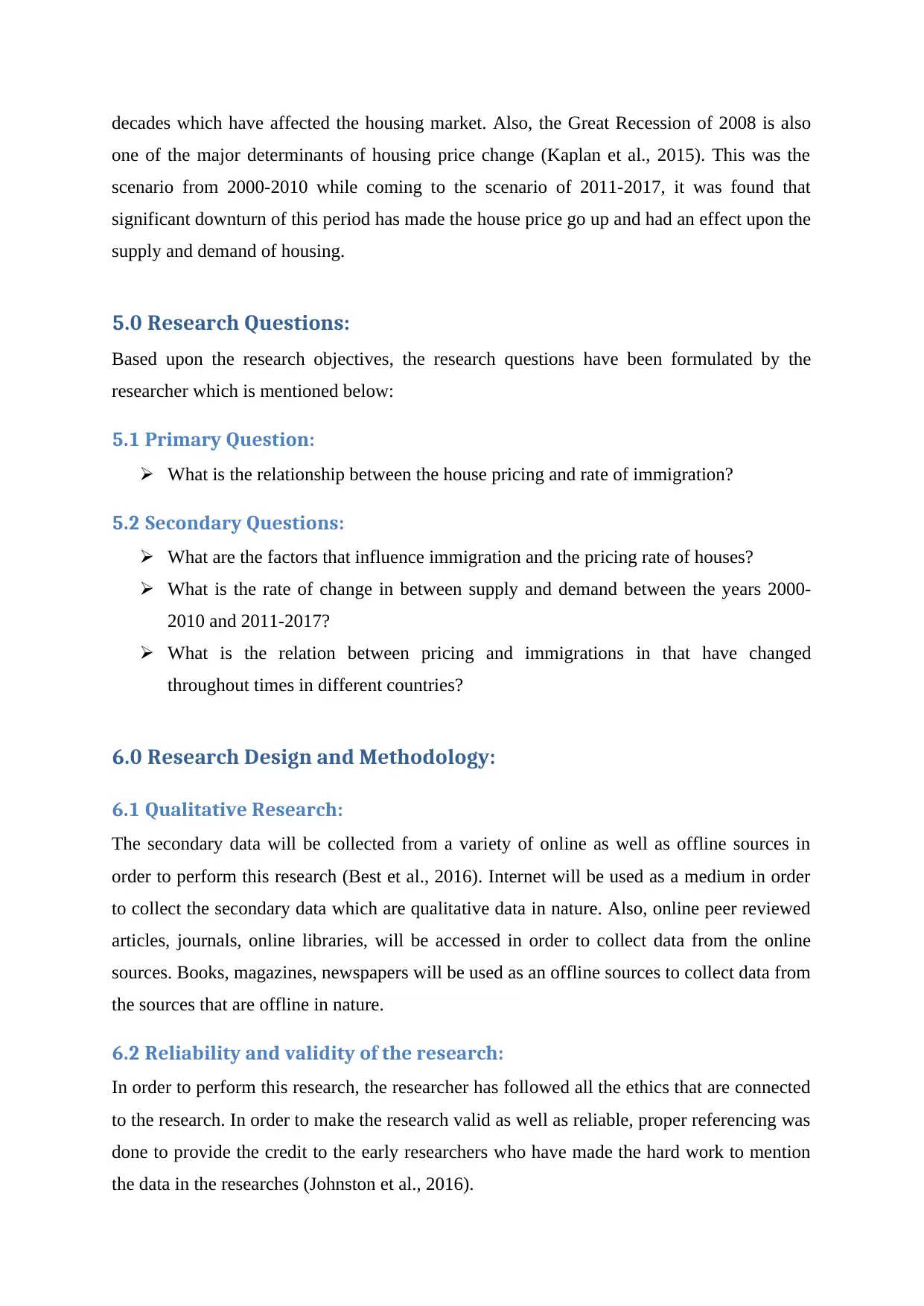
decades which have affected the housing market. Also, the Great Recession of 2008 is also
one of the major determinants of housing price change (Kaplan et al., 2015). This was the
scenario from 2000-2010 while coming to the scenario of 2011-2017, it was found that
significant downturn of this period has made the house price go up and had an effect upon the
supply and demand of housing.
5.0 Research Questions:
Based upon the research objectives, the research questions have been formulated by the
researcher which is mentioned below:
5.1 Primary Question:
What is the relationship between the house pricing and rate of immigration?
5.2 Secondary Questions:
What are the factors that influence immigration and the pricing rate of houses?
What is the rate of change in between supply and demand between the years 2000-
2010 and 2011-2017?
What is the relation between pricing and immigrations in that have changed
throughout times in different countries?
6.0 Research Design and Methodology:
6.1 Qualitative Research:
The secondary data will be collected from a variety of online as well as offline sources in
order to perform this research (Best et al., 2016). Internet will be used as a medium in order
to collect the secondary data which are qualitative data in nature. Also, online peer reviewed
articles, journals, online libraries, will be accessed in order to collect data from the online
sources. Books, magazines, newspapers will be used as an offline sources to collect data from
the sources that are offline in nature.
6.2 Reliability and validity of the research:
In order to perform this research, the researcher has followed all the ethics that are connected
to the research. In order to make the research valid as well as reliable, proper referencing was
done to provide the credit to the early researchers who have made the hard work to mention
the data in the researches (Johnston et al., 2016).
one of the major determinants of housing price change (Kaplan et al., 2015). This was the
scenario from 2000-2010 while coming to the scenario of 2011-2017, it was found that
significant downturn of this period has made the house price go up and had an effect upon the
supply and demand of housing.
5.0 Research Questions:
Based upon the research objectives, the research questions have been formulated by the
researcher which is mentioned below:
5.1 Primary Question:
What is the relationship between the house pricing and rate of immigration?
5.2 Secondary Questions:
What are the factors that influence immigration and the pricing rate of houses?
What is the rate of change in between supply and demand between the years 2000-
2010 and 2011-2017?
What is the relation between pricing and immigrations in that have changed
throughout times in different countries?
6.0 Research Design and Methodology:
6.1 Qualitative Research:
The secondary data will be collected from a variety of online as well as offline sources in
order to perform this research (Best et al., 2016). Internet will be used as a medium in order
to collect the secondary data which are qualitative data in nature. Also, online peer reviewed
articles, journals, online libraries, will be accessed in order to collect data from the online
sources. Books, magazines, newspapers will be used as an offline sources to collect data from
the sources that are offline in nature.
6.2 Reliability and validity of the research:
In order to perform this research, the researcher has followed all the ethics that are connected
to the research. In order to make the research valid as well as reliable, proper referencing was
done to provide the credit to the early researchers who have made the hard work to mention
the data in the researches (Johnston et al., 2016).
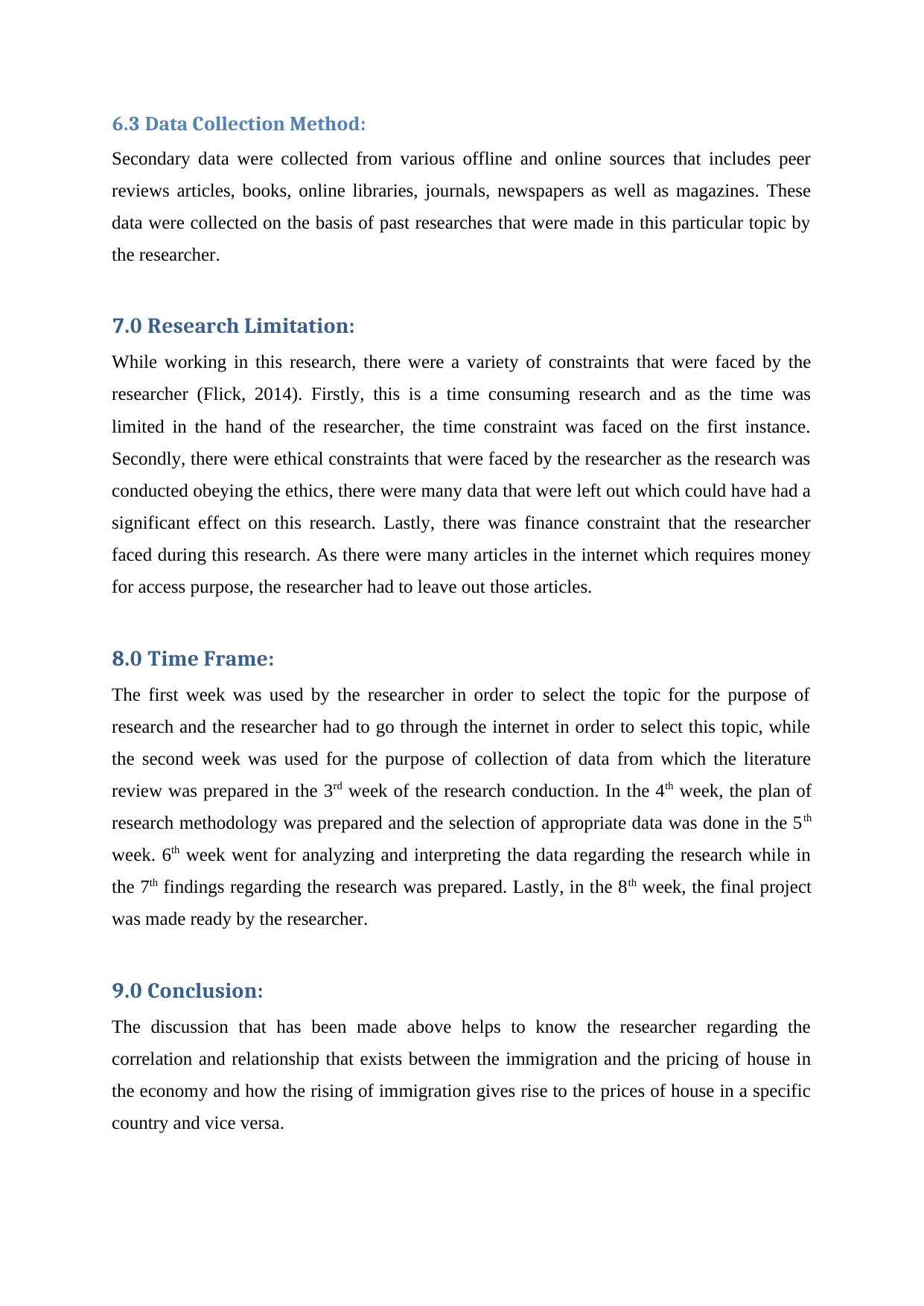
6.3 Data Collection Method:
Secondary data were collected from various offline and online sources that includes peer
reviews articles, books, online libraries, journals, newspapers as well as magazines. These
data were collected on the basis of past researches that were made in this particular topic by
the researcher.
7.0 Research Limitation:
While working in this research, there were a variety of constraints that were faced by the
researcher (Flick, 2014). Firstly, this is a time consuming research and as the time was
limited in the hand of the researcher, the time constraint was faced on the first instance.
Secondly, there were ethical constraints that were faced by the researcher as the research was
conducted obeying the ethics, there were many data that were left out which could have had a
significant effect on this research. Lastly, there was finance constraint that the researcher
faced during this research. As there were many articles in the internet which requires money
for access purpose, the researcher had to leave out those articles.
8.0 Time Frame:
The first week was used by the researcher in order to select the topic for the purpose of
research and the researcher had to go through the internet in order to select this topic, while
the second week was used for the purpose of collection of data from which the literature
review was prepared in the 3rd week of the research conduction. In the 4th week, the plan of
research methodology was prepared and the selection of appropriate data was done in the 5th
week. 6th week went for analyzing and interpreting the data regarding the research while in
the 7th findings regarding the research was prepared. Lastly, in the 8th week, the final project
was made ready by the researcher.
9.0 Conclusion:
The discussion that has been made above helps to know the researcher regarding the
correlation and relationship that exists between the immigration and the pricing of house in
the economy and how the rising of immigration gives rise to the prices of house in a specific
country and vice versa.
Secondary data were collected from various offline and online sources that includes peer
reviews articles, books, online libraries, journals, newspapers as well as magazines. These
data were collected on the basis of past researches that were made in this particular topic by
the researcher.
7.0 Research Limitation:
While working in this research, there were a variety of constraints that were faced by the
researcher (Flick, 2014). Firstly, this is a time consuming research and as the time was
limited in the hand of the researcher, the time constraint was faced on the first instance.
Secondly, there were ethical constraints that were faced by the researcher as the research was
conducted obeying the ethics, there were many data that were left out which could have had a
significant effect on this research. Lastly, there was finance constraint that the researcher
faced during this research. As there were many articles in the internet which requires money
for access purpose, the researcher had to leave out those articles.
8.0 Time Frame:
The first week was used by the researcher in order to select the topic for the purpose of
research and the researcher had to go through the internet in order to select this topic, while
the second week was used for the purpose of collection of data from which the literature
review was prepared in the 3rd week of the research conduction. In the 4th week, the plan of
research methodology was prepared and the selection of appropriate data was done in the 5th
week. 6th week went for analyzing and interpreting the data regarding the research while in
the 7th findings regarding the research was prepared. Lastly, in the 8th week, the final project
was made ready by the researcher.
9.0 Conclusion:
The discussion that has been made above helps to know the researcher regarding the
correlation and relationship that exists between the immigration and the pricing of house in
the economy and how the rising of immigration gives rise to the prices of house in a specific
country and vice versa.
⊘ This is a preview!⊘
Do you want full access?
Subscribe today to unlock all pages.

Trusted by 1+ million students worldwide
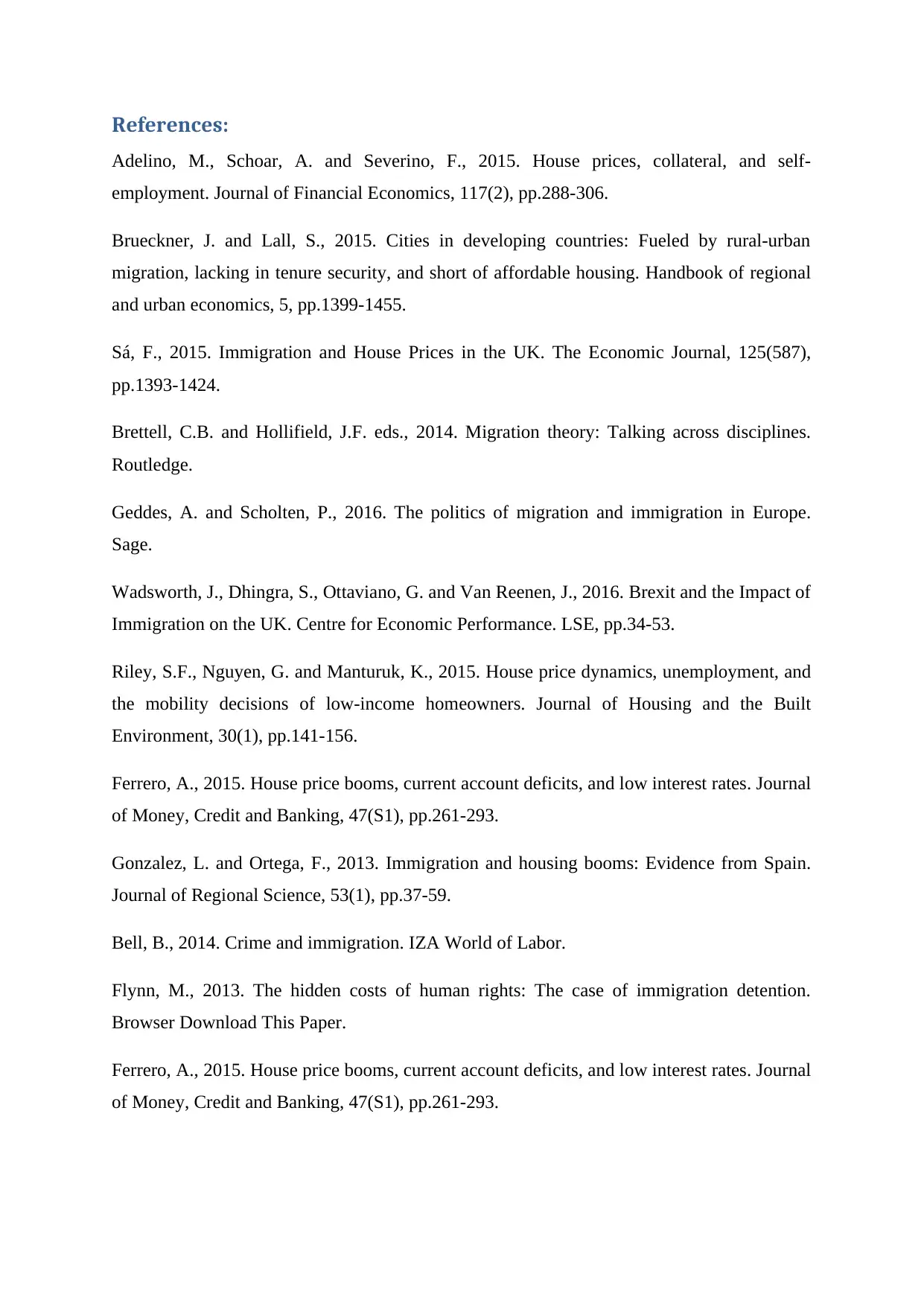
References:
Adelino, M., Schoar, A. and Severino, F., 2015. House prices, collateral, and self-
employment. Journal of Financial Economics, 117(2), pp.288-306.
Brueckner, J. and Lall, S., 2015. Cities in developing countries: Fueled by rural-urban
migration, lacking in tenure security, and short of affordable housing. Handbook of regional
and urban economics, 5, pp.1399-1455.
Sá, F., 2015. Immigration and House Prices in the UK. The Economic Journal, 125(587),
pp.1393-1424.
Brettell, C.B. and Hollifield, J.F. eds., 2014. Migration theory: Talking across disciplines.
Routledge.
Geddes, A. and Scholten, P., 2016. The politics of migration and immigration in Europe.
Sage.
Wadsworth, J., Dhingra, S., Ottaviano, G. and Van Reenen, J., 2016. Brexit and the Impact of
Immigration on the UK. Centre for Economic Performance. LSE, pp.34-53.
Riley, S.F., Nguyen, G. and Manturuk, K., 2015. House price dynamics, unemployment, and
the mobility decisions of low-income homeowners. Journal of Housing and the Built
Environment, 30(1), pp.141-156.
Ferrero, A., 2015. House price booms, current account deficits, and low interest rates. Journal
of Money, Credit and Banking, 47(S1), pp.261-293.
Gonzalez, L. and Ortega, F., 2013. Immigration and housing booms: Evidence from Spain.
Journal of Regional Science, 53(1), pp.37-59.
Bell, B., 2014. Crime and immigration. IZA World of Labor.
Flynn, M., 2013. The hidden costs of human rights: The case of immigration detention.
Browser Download This Paper.
Ferrero, A., 2015. House price booms, current account deficits, and low interest rates. Journal
of Money, Credit and Banking, 47(S1), pp.261-293.
Adelino, M., Schoar, A. and Severino, F., 2015. House prices, collateral, and self-
employment. Journal of Financial Economics, 117(2), pp.288-306.
Brueckner, J. and Lall, S., 2015. Cities in developing countries: Fueled by rural-urban
migration, lacking in tenure security, and short of affordable housing. Handbook of regional
and urban economics, 5, pp.1399-1455.
Sá, F., 2015. Immigration and House Prices in the UK. The Economic Journal, 125(587),
pp.1393-1424.
Brettell, C.B. and Hollifield, J.F. eds., 2014. Migration theory: Talking across disciplines.
Routledge.
Geddes, A. and Scholten, P., 2016. The politics of migration and immigration in Europe.
Sage.
Wadsworth, J., Dhingra, S., Ottaviano, G. and Van Reenen, J., 2016. Brexit and the Impact of
Immigration on the UK. Centre for Economic Performance. LSE, pp.34-53.
Riley, S.F., Nguyen, G. and Manturuk, K., 2015. House price dynamics, unemployment, and
the mobility decisions of low-income homeowners. Journal of Housing and the Built
Environment, 30(1), pp.141-156.
Ferrero, A., 2015. House price booms, current account deficits, and low interest rates. Journal
of Money, Credit and Banking, 47(S1), pp.261-293.
Gonzalez, L. and Ortega, F., 2013. Immigration and housing booms: Evidence from Spain.
Journal of Regional Science, 53(1), pp.37-59.
Bell, B., 2014. Crime and immigration. IZA World of Labor.
Flynn, M., 2013. The hidden costs of human rights: The case of immigration detention.
Browser Download This Paper.
Ferrero, A., 2015. House price booms, current account deficits, and low interest rates. Journal
of Money, Credit and Banking, 47(S1), pp.261-293.
Paraphrase This Document
Need a fresh take? Get an instant paraphrase of this document with our AI Paraphraser
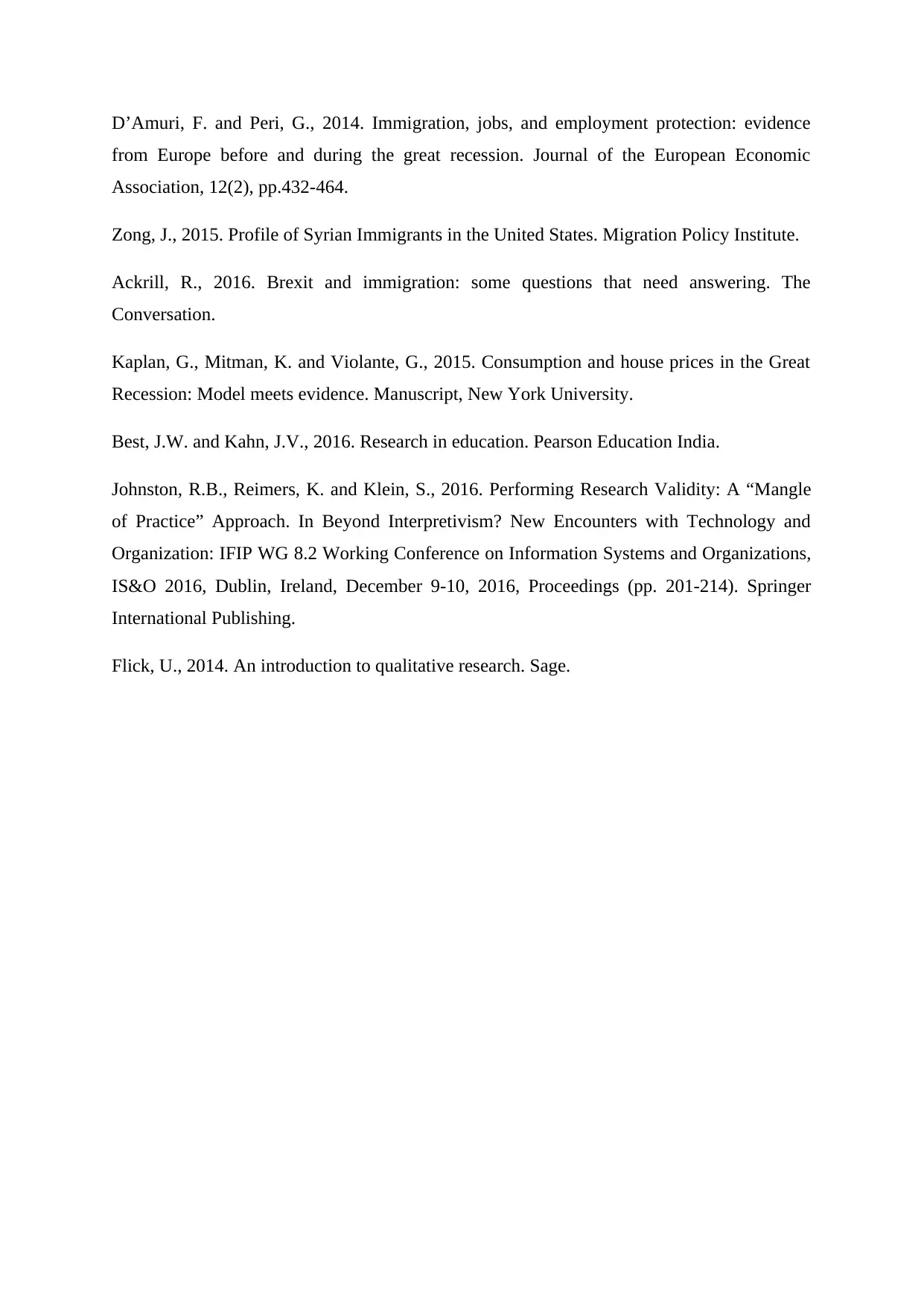
D’Amuri, F. and Peri, G., 2014. Immigration, jobs, and employment protection: evidence
from Europe before and during the great recession. Journal of the European Economic
Association, 12(2), pp.432-464.
Zong, J., 2015. Profile of Syrian Immigrants in the United States. Migration Policy Institute.
Ackrill, R., 2016. Brexit and immigration: some questions that need answering. The
Conversation.
Kaplan, G., Mitman, K. and Violante, G., 2015. Consumption and house prices in the Great
Recession: Model meets evidence. Manuscript, New York University.
Best, J.W. and Kahn, J.V., 2016. Research in education. Pearson Education India.
Johnston, R.B., Reimers, K. and Klein, S., 2016. Performing Research Validity: A “Mangle
of Practice” Approach. In Beyond Interpretivism? New Encounters with Technology and
Organization: IFIP WG 8.2 Working Conference on Information Systems and Organizations,
IS&O 2016, Dublin, Ireland, December 9-10, 2016, Proceedings (pp. 201-214). Springer
International Publishing.
Flick, U., 2014. An introduction to qualitative research. Sage.
from Europe before and during the great recession. Journal of the European Economic
Association, 12(2), pp.432-464.
Zong, J., 2015. Profile of Syrian Immigrants in the United States. Migration Policy Institute.
Ackrill, R., 2016. Brexit and immigration: some questions that need answering. The
Conversation.
Kaplan, G., Mitman, K. and Violante, G., 2015. Consumption and house prices in the Great
Recession: Model meets evidence. Manuscript, New York University.
Best, J.W. and Kahn, J.V., 2016. Research in education. Pearson Education India.
Johnston, R.B., Reimers, K. and Klein, S., 2016. Performing Research Validity: A “Mangle
of Practice” Approach. In Beyond Interpretivism? New Encounters with Technology and
Organization: IFIP WG 8.2 Working Conference on Information Systems and Organizations,
IS&O 2016, Dublin, Ireland, December 9-10, 2016, Proceedings (pp. 201-214). Springer
International Publishing.
Flick, U., 2014. An introduction to qualitative research. Sage.
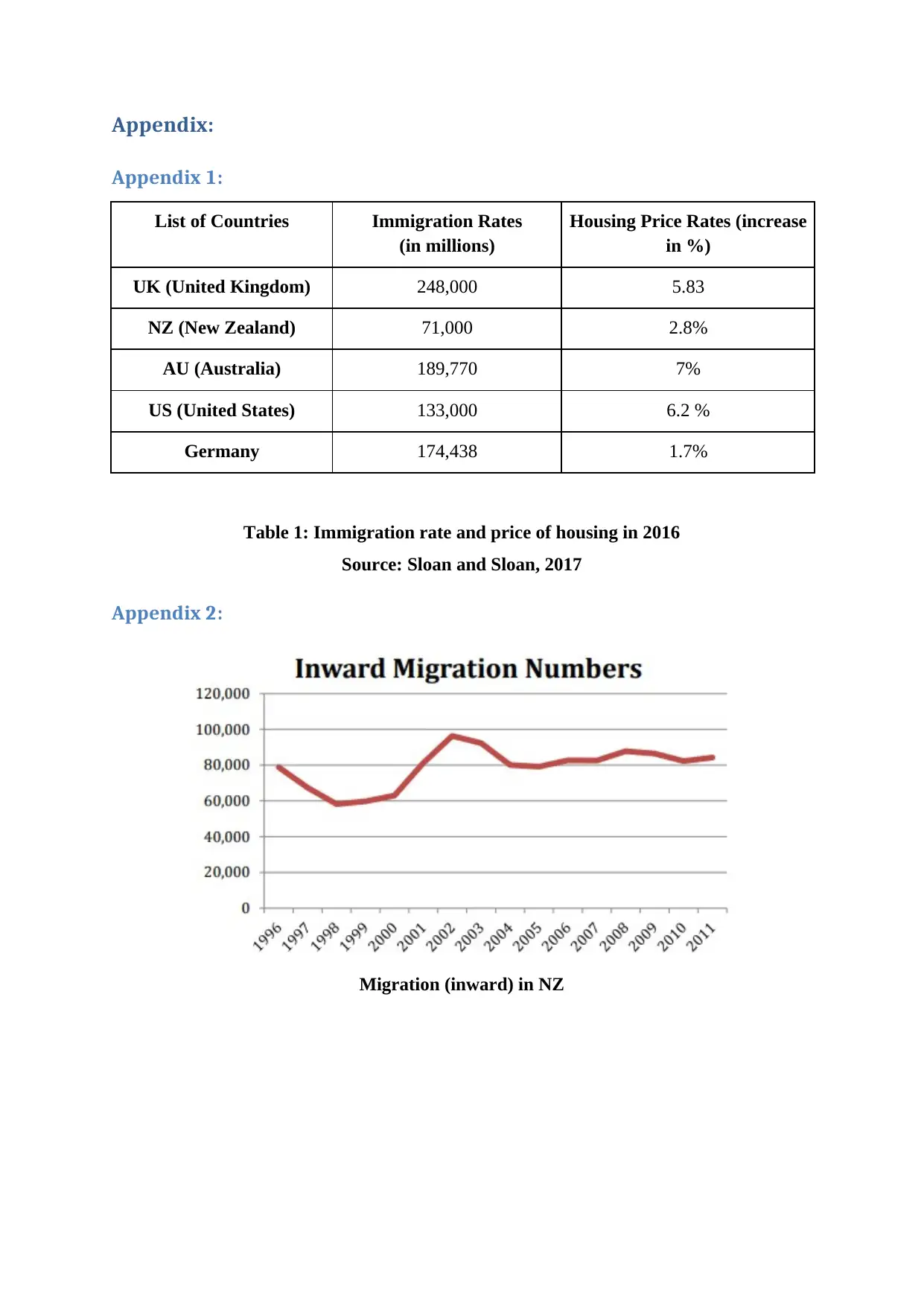
Appendix:
Appendix 1:
List of Countries Immigration Rates
(in millions)
Housing Price Rates (increase
in %)
UK (United Kingdom) 248,000 5.83
NZ (New Zealand) 71,000 2.8%
AU (Australia) 189,770 7%
US (United States) 133,000 6.2 %
Germany 174,438 1.7%
Table 1: Immigration rate and price of housing in 2016
Source: Sloan and Sloan, 2017
Appendix 2:
Migration (inward) in NZ
Appendix 1:
List of Countries Immigration Rates
(in millions)
Housing Price Rates (increase
in %)
UK (United Kingdom) 248,000 5.83
NZ (New Zealand) 71,000 2.8%
AU (Australia) 189,770 7%
US (United States) 133,000 6.2 %
Germany 174,438 1.7%
Table 1: Immigration rate and price of housing in 2016
Source: Sloan and Sloan, 2017
Appendix 2:
Migration (inward) in NZ
⊘ This is a preview!⊘
Do you want full access?
Subscribe today to unlock all pages.

Trusted by 1+ million students worldwide
1 out of 15
Related Documents
Your All-in-One AI-Powered Toolkit for Academic Success.
+13062052269
info@desklib.com
Available 24*7 on WhatsApp / Email
![[object Object]](/_next/static/media/star-bottom.7253800d.svg)
Unlock your academic potential
Copyright © 2020–2025 A2Z Services. All Rights Reserved. Developed and managed by ZUCOL.





